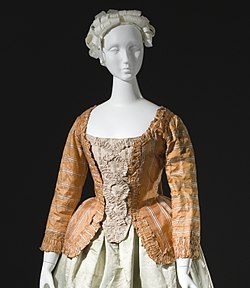Caraco

A caraco is a style of woman's
gowns of the period, the back of the caraco could be fitted to the waist or could hang in pleats from the shoulder in the style of a sack back. Caracos were generally made of printed linen or cotton.[1][2]
The caraco emerged as an informal style in France in the 1760s,[1] based on working-class jackets. It was worn with a petticoat and, if open in front, a stomacher or decorative stays. The English caraco was generally closed in front. A similar garment with a wrap front, called in English a bedgown or short gown, was the standard working woman's costume of the later 18th century.[1]
Gallery
Women's jackets and short gowns of the 18th century
-
The Chocolate Girl, 1743–45, wears a fitted jacket, petticoat, and apron.
-
Working woman's bedgown and petticoat, 1764.
-
Caraco jacket in printed cotton and skirt in quilted silk satin, 1770-1790,ModeMuseum Provincie Antwerpen.
-
Drawing of a Caraco, by David Ring.
Notes
References
- Cumming, Valerie, C. W. Cunnington and P. E. Cunnington. The Dictionary of Fashion History, Berg, 2010, ISBN 978-1-84788-533-3
- Takeda, Sharon Sadako, and Kaye Durland Spilker, Fashioning Fashion: European Dress in Detail, 1700 - 1915, Prestel USA (2010), ISBN 978-3-7913-5062-2





